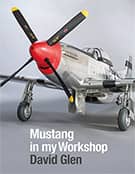Fire bulkhead - first finished detail
Monday, 9th September, 2013
Having aged by the most of two decades since starting my Spitfire Mk I, my appreciation of the value of time has come to preclude its expenditure on putting detail into models that will be visible only with a dental mirror or medical catheter! Thus I decided early on to include the fire protecting bulkhead in my Mk IX - a feature absent from my Mk I model - thereby saving myself a whole heap of work in developing and kitting out that part of the lower fuselage between the pilot’s feet and Frame 5.
The fire bulkhead, or parts of it, are tantalisingly visible just forward of the rudder pedals in the photographs of a stripped down Mk IX in Paul Monforton’s book, Spitfire Engineered, but not sufficiently so to work from with any degree of confidence. Fortunately I had the Supermarine GA (Sheet 122G). First though, a confession:
In all models there are compromises, and here I make my first. In reality the fire bulkhead slopes backward at an angle of about 10 degrees from the floor of the fuselage immediately aft of Frame 7 to just forward of the instrument panel at waist longeron level, thereby creating a barrier of sorts beneath the overlying fuel tank. Again, on the basis of not wanting to spend valuable time on a feature that itself would be barely visible, I decided to orientate it vertically, thus making use for its foundation of the closest plywood section. This is numbered 7 in the Monforton drawings but is actually located just aft of the real Frame 7 and is thus spurious in the full sized aircraft.
From then on the job involved little more than enlarging the drawing to scale size and using it to cut the numerous individual litho plate pieces. These were attached to the ply section with contact adhesive and or cyanoacrylate, and the many bolts (I used 14 BA as being close to scale size) put in afterwards. The work was made interesting by the irregular geometry of the central part of bulkhead, which protrudes backwards, presumably to create clearance, and by the two circular wells, which I assume are there to accommodate the extreme travel of the rudder bars.
This first detailed feature of the model, which I tackled back in June this year, was a relatively simple undertaking, yet it illustrates how, even with the production drawings, it is not always easy for a model maker lacking factory floor or drawing office experience to interpret what is going on with 100 per cent precision. Good clear photographs of the finished component become vital, and inevitably in the cramped confines of an aircraft, even these tend to be ambiguous. I think I’ve got this particular feature mostly right, yet had not it been almost entirely hidden from view, I would certainly have wanted to trawl for further visual references.






